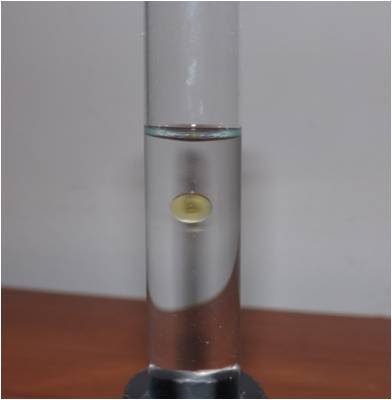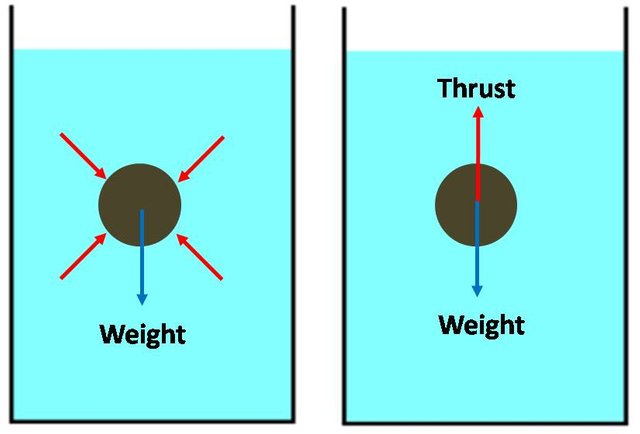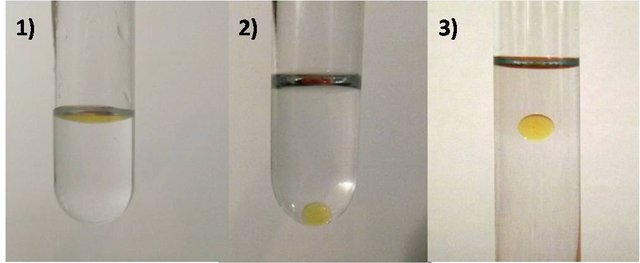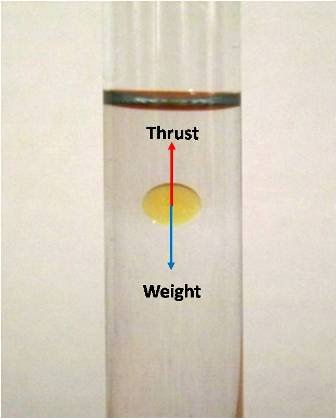The mystery of a weightless drop. Demonstration of the Archimedes’ principle
Greetings dear friends of steemit.
Some of the best experiences that I have presented to teach chemistry have been done as a game, in which students are challenged to think. In this case, when we talked about the properties of liquids, I prepared a practical experience for a group of students in which they could highlight the concept of density and at the same time demonstrate the Archimedes’ principle, in order to surprise them and motivate them to seek the explanation of how it is possible for a drop of oil to be suspended, as if levitating, inside another liquid.

Drop of oil floating in the middle of a liquid. Own image.
Surely we have all observed that when entering a bathtub, the water level increases, just as it happens when introducing any object in a container full of any liquid, if the object is denser than the water it sinks and occupies a space in the inside the liquid, displacing a quantity of liquid equivalent to its volume, causing the level to increase.
Another phenomenon is a little less obvious, but we can feel it in bodies that are submerged; perhaps when entering a pool you have felt that you weigh less, it is even easier to push yourself out of the pool, or that it is easier to move objects when they are submerged than when they are out of the water. This is possible because a body that is totally or partially immersed in a fluid experiences a pushing force in the opposite direction to its weight, this pushing force is what determines the buoyancy of a body, and is what makes a body seem lighter in the water.

Forces acting on a sumerged body. Own image.
This phenomenon of flotation is due to the fact that when a body is submerged in a liquid, the liquid exerts pressure on the walls of the body. The forces that act laterally are balanced against each other, since they have the same value at the same depth, but this does not happen with the forces that act on the top and bottom, on the one hand the weight of the body pushes it down, and on the other, the pushing force applied by the liquid takes it upwards. And as the pressure is greater in greater depth, the forces exerted on the lower part are greater than those exerted on the upper part, so that the resultant of these two forces is directed upwards, tending to prevent the body from sinking.
Then, since the volume of the submerged body is equal to the volume of fluid displaced, the pushing force has a magnitude equal to the weight of the liquid displaced by the submerged object, this quantity is expressed as ρ*V*g.
This thrust experienced by the bodies was studied by the Greek scientist Archimedes of Syracuse and is called the Principle of Archimedes in his honor, this principle expresses that:
“A body at rest, immersed in a fluid, experiences a force pushing upward equal to the weight of the volume of the fluid that the body displaces.”

Portrait of Archimedes thoughtfull, by Domenico Fetti. Image source: wikimedia commons, image public domain.
So the density of the fluid is also important, because the more dense the liquid, the greater the mass will be per unit volume, and the pushing force will be greater.
To test the principle we have taken three test tubes. In one of them we will place a portion of water and over it a drop of oil, in the second we will add methanol and a drop of oil; and in the third, we will first place a portion of water followed by a drop of oil and finally a portion of alcohol (we must be careful to add them carefully so as not to shake the contents of the container).
The result:

Experiment with the drop of oil in: 1) water, 2) methanol and 3) mix methanol water. Own image.
We will notice that in the first tube the oil floats on the water, in the second the drop of oil sinks in the liquid, and in the third we will observe the drop of oil submerged in the liquid without sinking, as if levitating inside.
This is a play of densities: water has a higher density than oil, which in turn is denser than methanol. Thus, the oil floats on the water in the first container, but sinks if we add it on alcohol (second container); in the case of the third container what we observe is the combined effect of the first two, forming a drop that neither floats nor sinks. In the third container, when alcohol is added to the water, a mixture with a density similar to that of the oil is obtained, and by the Archimedes principle the forces acting on it equilibrate, producing the body to float in equilibrium in the liquid interior.

Drop of oil in balance. Own image.
The principle of Archimedes is applied to bodies of any density, thus, depending on the density; it is possible to determine the behavior of the object when being submerged in a fluid, being able to be:
1) If the body is denser than the fluid in which it is submerged, the body will sink.
2) If the body is less dense than the fluid in which it is submerged, the body will float on the surface.
3) If the density of the body is equal to the density of the fluid in which it is submerged, the body will neither float nor sink, it will remain in equilibrium in any part of the fluid.
This experiment also shows the effect that surface tension has on the shape of liquids. Generally, gravity causes the liquids to take the shape of the recipient that contains them, but being submerged inside another liquid of the same density, their weight is balanced by the thrust, and this adopts the spherical shape that the drop oil acquires.
Some of the applications of the Archimedes principle are the flotation of ships, submarines and lifeguards. The large and heavy ships float because they are designed so that their submerged part displaces a volume of water whose weight is greater than the weight of the ship. A submarine normally floats, but the submarines can vary their weight allowing to enter water at the tanks of ballast, controlling like this its density and with it its buoyancy. And when we put on a lifejacket we can increase the volume without adding much weight, reducing the total density, producing that we can float easily.
Thank you so much for reading this article, I hope you enjoyed the information.

References:
Encyclopaedia Britannica. Archimedes´principle.
Wikipedia. Archimedes´principle.
This post has been voted on by the SteemSTEM curation team and voting trail. It is elligible for support from @curie.
If you appreciate the work we are doing, then consider supporting our witness stem.witness. Additional witness support to the curie witness would be appreciated as well.
For additional information please join us on the SteemSTEM discord and to get to know the rest of the community!
Please consider setting @steemstem as a beneficiary to your post to get a stronger support.
Please consider using the steemstem.io app to get a stronger support.